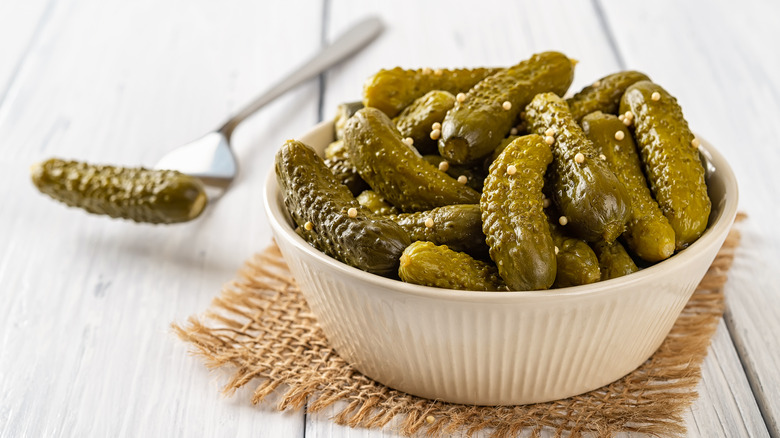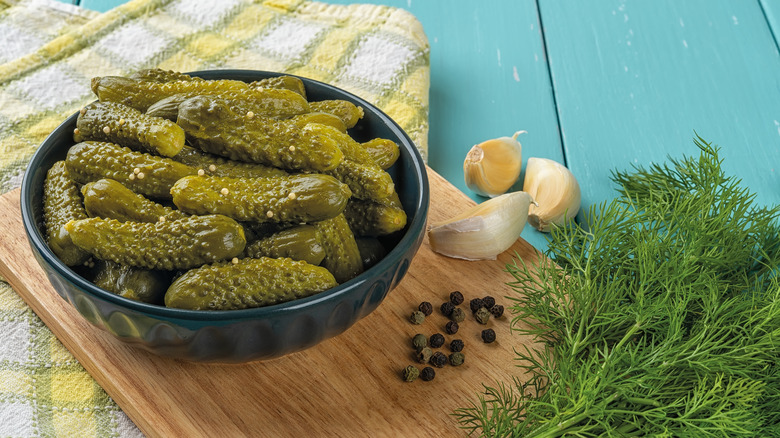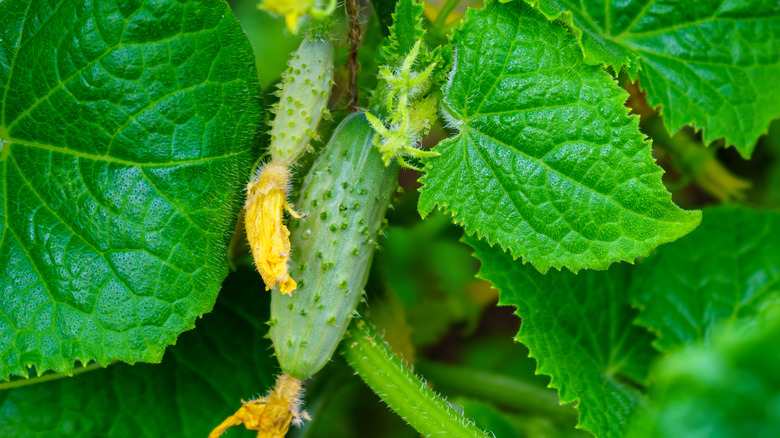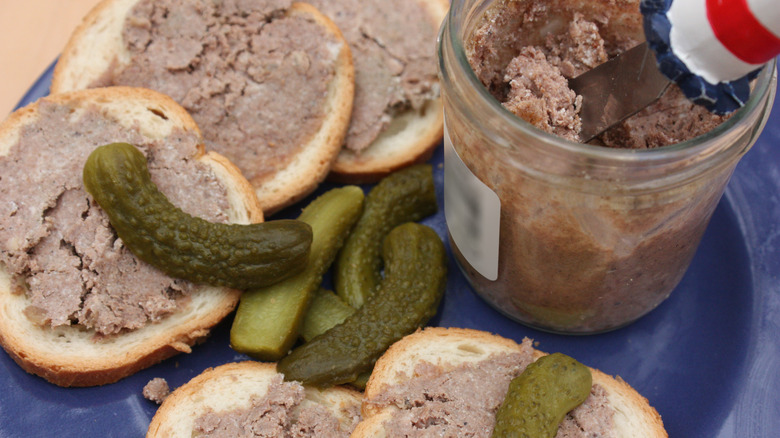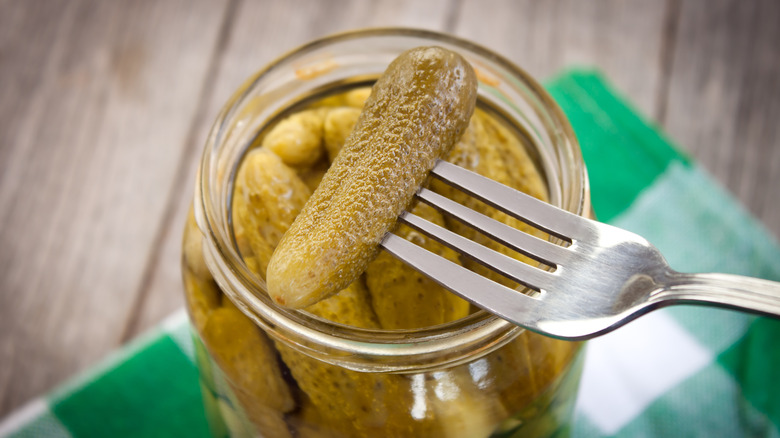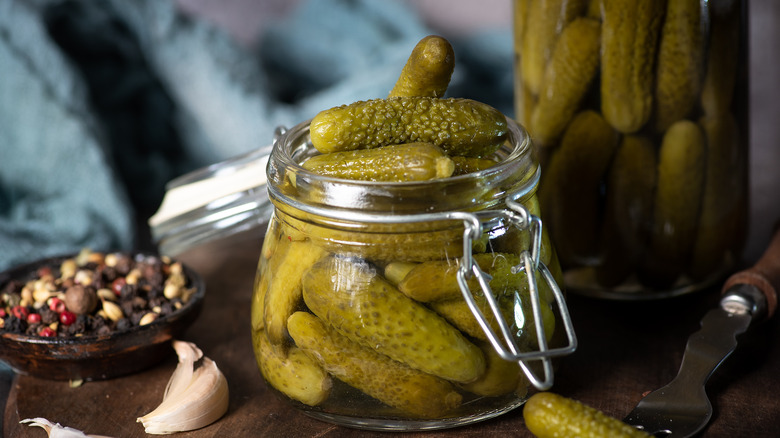What Is A Cornichon And How Does It Taste?
We may receive a commission on purchases made from links.
If you've ever spotted a dish of cornichons on a charcuterie board and didn't know what they were, you might have wondered how those pickles got so small. After all, they look exactly like regular pickled cucumbers, the kind you like to have alongside your ham and cheese sandwiches, only they look like they were put through a shrinking machine. Usually less than two inches long and about a quarter inch in diameter, these adorable little garnishes taste an awful lot like dill pickles, too, only perhaps a bit less tart.
With a mild tang and a satisfying crunch, cornichons (pronounced like core-ni-shance) are the same pickled veggie that the English refer to as gherkins. They are dubbed "cornichons" by the French and are known as such in America as well. The unique flavor of cornichons makes them a great foil to the super-savory flavors of meat and cheese platters, and anything else that is heavy on the umami. Plus, with their tiny size, they act as an excellent little condiment, not a supersized, sour side dish like those giant pickles found in Jewish delis (which are great with pastrami and corned beef, by the way). Anyone who loves pickles will probably be dill-ighted by the petite size and subtle sourness of the tiny but mighty cornichon.
What do cornichons taste like?
Even though cornichons are first cured in salt, they don't take on an overwhelming salty flavor. Once pickled, they are tart, but not super sour. As tiny as they are, cornichons maintain a crisp texture which almost gives them a refreshing quality when combined with their mild tartness. Some describe them as a little sweet but they shouldn't be nearly as sweet as legit sweet pickles. In reality, cornichons will take on the flavors of whatever they are pickled with, whether that's peppercorns, fresh dill, sugar, or other herbs and spices.
Many times, cornichons have a much bumpier skin than regular-sized pickles and their rougher texture complements things like smooth meat patés and salmon rillettes. They are briny, sharp, and cut right through rich and fatty foods to complement what you're eating and cleanse your palate at the same time. Occasionally, you'll see jars of cornichons with tiny pearl onions and mustard seeds inside. The pearl onions are also delicious to eat and, if you pick up some mustard seeds with your cornichon, you'll get an even more tasty texture.
How are cornichons made?
Cornichons begin with a type of cucumber called gherkin cucumbers. Small, bright green, and bumpy, they remain tiny when they reach full maturity, but are deliberately harvested while young and between one and two inches in length. The pickling process begins with the gherkins being salted overnight to draw out some of their liquid. They are then soaked in vinegar and left overnight again. At this point, the gherkins and liquid are cooked, cooled, and then sealed in jars along with flavorings like herbs and those tiny onions mentioned earlier.
Anyone who cans or makes their own pickles shouldn't have a hard time making their own cornichons, too. As long as the correct type of cucumbers are used, the method is very much like making standard pickles and is pretty straight forward. They can be canned in the hot water bath method for extended storage, or placed right into the refrigerator (without the canning) if you'll consume them quicker, and no one will blame you if you do.
How to serve and where to buy them
Cornichons have been a long-time accompaniment in France to things like liver patés and meat terrines. Any rich, meaty dish is delicious with the sharp tang of these little pickles. They work with steak tartare, in egg salad and deviled eggs, and mixed into tuna salad. A very popular French sandwich called jamon buerre features a buttered baguette filled with ham, Dijon mustard, and cornichons which compliment the rich butter and pork.
Of course, any charcuterie board or relish tray isn't complete without something briny and tangy and cornichons are perfect for these. Because of their size, they are also great for cocktails, like garnishing martinis and Bloody Mary's.
Cornichons have become fairly popular and are now, therefore, pretty readily available at most larger supermarket chains. You can typically find them close to other pickles, or in the international aisle. French or other European brands may have to be purchased online, with retailers like Amazon offering dozens of brands and sizes of jars. Once you get a taste for these tart little gems, you'll probably find yourself making sure they are in constant supply in your fridge, right alongside your kosher dills and bread and butter slices.
How to store cornichons
Jarred cornichons have a long shelf-life. The salty and acidic vinegar brine that the gherkins are preserved in helps to deter the growth of bacteria. When properly stored, an unopened jar can last anywhere from one to two years or even longer. To stay on the safe side, it's always a good idea to follow the guidance on the product's "best by" date.
Once you've opened a jar of cornichons, it should be stored in the refrigerator. According to the USDA, they can be kept in the fridge for one to three months. How long an open jar of pickles can be maximized by keeping the little pickles in their original jar — or any container with a tight-fitting lid. They should be stored in their pickling liquid, which keeps them from drying out and going bad. Also, resist the urge to reach into the jar with your fingers as this can introduce germs — instead, use a fork or tongs to get them out.
Like their regular-sized pickle cousins, cornichons can also spoil. You'll know they've turned bad if they develop an overpowering odor. This can include smelling particularly sour or foul. Look for discoloration, browning, or cloudiness on the gherkins or in their liquid. Mold can also develop on the pickles or in the juice. If you notice any of these signs of spoilage, the cornichons need to be discarded and should not be consumed.
Nutritional information about cornichons
Depending on how they're made, most commercially available cornichons do not provide a lot of nutrients. Typically, they have few to no calories per serving (usually around 1 ounce, or the equivalent of seven pickles), as well as no fat, carbs, sugars, protein, or cholesterol. In most cases, they are vegan, gluten-free, as well as keto and paleo-friendly.
One element that cornichons are often high in, however, is sodium. The popular Maille brand's original variety of cornichons contains 230 milligrams per serving, which is 10% of the recommended daily value. The brand also uses sulphites as a preservative, which certain people, especially asthmatics, may be sensitive or allergic to (per Cleveland Clinic). Whole Foods Market 365 brand cornichons are similarly high in sodium, with 280 milligrams per serving (12% RDV). Consuming too much sodium can lead to high blood pressure, which increases the risk of strokes and heart disease (per CDC), so those watching their intake should be aware of the sodium content in cornichons.
On the other hand, that same salty brine can actually be beneficial when you're dehydrated or hungover. Pickle juice is an underrated hydration powerhouse, thanks to being packed with electrolytes including sodium. Drinking pickle juice will not only provide a quick pick-me-up on a hot day or after a sweaty run, but it can also help with muscle cramps as an alternative to Gatorade or other similar sports drinks (via Healthline).

